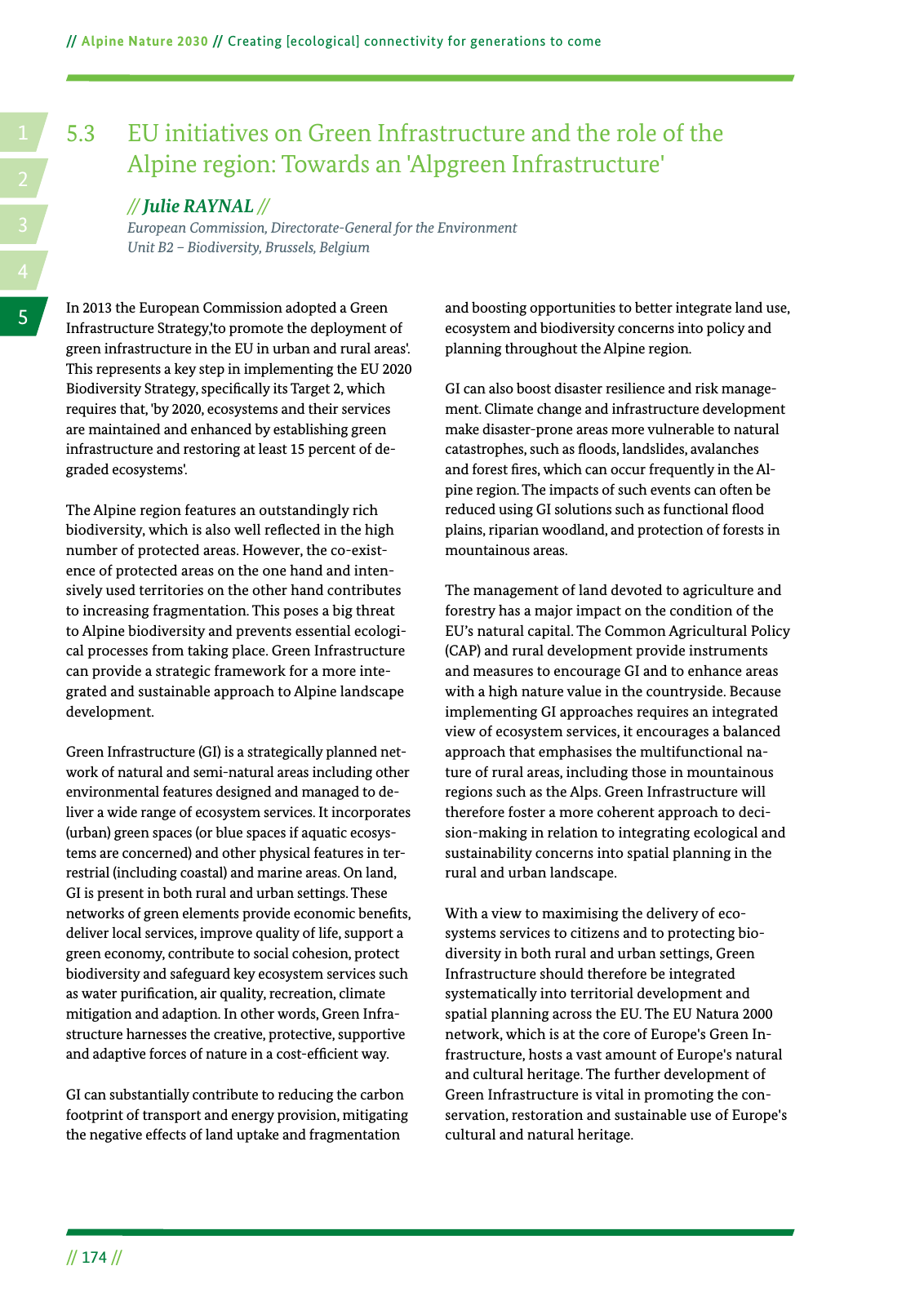14 2 5 3 Alpine Nature 2030 Creating ecological connectivity for generations to come 174 In 2013 the European Commission adopted a Green Infrastructure Strategy to promote the deployment of green infrastructure in the EU in urban and rural areas This represents a key step in implementing the EU 2020 Biodiversity Strategy speci cally its Target 2 which requires that by 2020 ecosystems and their services are maintained and enhanced by establishing green infrastructure and restoring at least 15 percent of de graded ecosystems The Alpine region features an outstandingly rich biodiversity which is also well re ected in the high number of protected areas However the co exist ence of protected areas on the one hand and inten sively used territories on the other hand contributes to increasing fragmentation This poses a big threat to Alpine biodiversity and prevents essential ecologi cal processes from taking place Green Infrastructure can provide a strategic framework for a more inte grated and sustainable approach to Alpine landscape development Green Infrastructure GI is a strategically planned net work of natural and semi natural areas including other environmental features designed and managed to de liver a wide range of ecosystem services It incorporates urban green spaces or blue spaces if aquatic ecosys tems are concerned and other physical features in ter restrial including coastal and marine areas On land GI is present in both rural and urban settings These networks of green elements provide economic bene ts deliver local services improve quality of life support a green economy contribute to social cohesion protect biodiversity and safeguard key ecosystem services such as water puri cation air quality recreation climate mitigation and adaption In other words Green Infra structure harnesses the creative protective supportive and adaptive forces of nature in a cost ef cient way GI can substantially contribute to reducing the carbon footprint of transport and energy provision mitigating the negative effects of land uptake and fragmentation 5 3 EU initiatives on Green Infrastructure and the role of the Alpine region Towards an Alpgreen Infrastructure and boosting opportunities to better integrate land use ecosystem and biodiversity concerns into policy and planning throughout the Alpine region GI can also boost disaster resilience and risk manage ment Climate change and infrastructure development make disaster prone areas more vulnerable to natural catastrophes such as oods landslides avalanches and forest res which can occur frequently in the Al pine region The impacts of such events can often be reduced using GI solutions such as functional ood plains riparian woodland and protection of forests in mountainous areas The management of land devoted to agriculture and forestry has a major impact on the condition of the EU s natural capital The Common Agricultural Policy CAP and rural development provide instruments and measures to encourage GI and to enhance areas with a high nature value in the countryside Because implementing GI approaches requires an integrated view of ecosystem services it encourages a balanced approach that emphasises the multifunctional na ture of rural areas including those in mountainous regions such as the Alps Green Infrastructure will therefore foster a more coherent approach to deci sion making in relation to integrating ecological and sustainability concerns into spatial planning in the rural and urban landscape With a view to maximising the delivery of eco systems services to citizens and to protecting bio diversity in both rural and urban settings Green Infrastructure should therefore be integrated systematically into territorial development and spatial planning across the EU The EU Natura 2000 network which is at the core of Europe s Green In frastructure hosts a vast amount of Europe s natural and cultural heritage The further development of Green Infrastructure is vital in promoting the con servation restoration and sustainable use of Europe s cultural and natural heritage Julie RAYNAL European Commission Directorate General for the Environment Unit B2 Biodiversity Brussels Belgium

Hinweis: Dies ist eine maschinenlesbare No-Flash Ansicht.
Klicken Sie hier um zur Online-Version zu gelangen.
Klicken Sie hier um zur Online-Version zu gelangen.